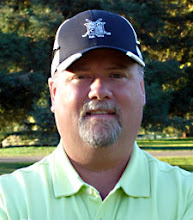No overseed, the right decision?
Without any poa on our dormant bermuda, many places would look like the photograph below. The bermuda has not developed much of a thatch layer so the dormant blades will fall apart very quickly leaving little besides mud to play on. This picture is one of the worst spots on #10 which is in its second year of not being overseeded. Next year, we should be able to keep the poa annua out and have a dormant mat to play on. #11 is in its third year and has held up very well. I made the mistake of not applying pre-emergent herbicide to 11 fairway and now poa annua has came in small clumps. The bermuda is very playable so the cool season grass is not needed.


This next pic is the same fairway and the same dormant patch from a different angle. You can see that the poa has filled in very well and there is a decent playing surface, although far from perfect. The 10th hole is currently one of the worst conditioned fairways on the course. The 17th hole is probably thinner, and muddier than any other hole. We sprayed the fairway with a product called Revolver to remove the poa annua and ryegrass to allow the bermuda to take charge. By the end of summer, this was a pretty nice fairway and next year will be even better.

Every fairway that hasn't been treated with Revolver has more ryegrass and more annual bluegrass to cover up the dormant bermuda. The population of cool season grass makes a trasition into winter less noticeable and gives us fairways that look like this:

This is number 12 and a good example of what the rest of our fairways look like The darker shade of grass along the ridge in the middle and up the distant, left side of the fairway is perennial ryegrass. Everything else is filled in with poa annua.
Many superintendents would disagree with the practice of letting in all of this poa. I opted to let it come in to provide a playing surface for the winter without the cost of overseeding. Without this poa, there would be many, many spots that look like the muddy ground in the first image. So, we are able to have grass in the winter without the cost of overseeding or the messy process of getting the seed in the ground, germinated, and grown to maturity. When warmer temperatures arrive, we will start to lose this poa annua more quickly than we would lose a stand of seeded ryegrass. This will lead to a quicker transition to bermuda and we can start to build up that dormant mat we want in future off-seasons.
The membership has been very happy and pretty surprised at the results of not overseeding. Many people expected nothing but mud and unplayable conditions. As usual, winter here does not offer the best in playability due to our soil types and extreme proximity to ground water. However, that would be the case if we did overseed or not. Besides a lighter green appearance, most fairways are very similar to what they would be with the $30,000 bill.
Now if we could just dry out enough to mow, we would be in business. More about that in the next post. Thanks for reading.


0 comments:
Post a Comment